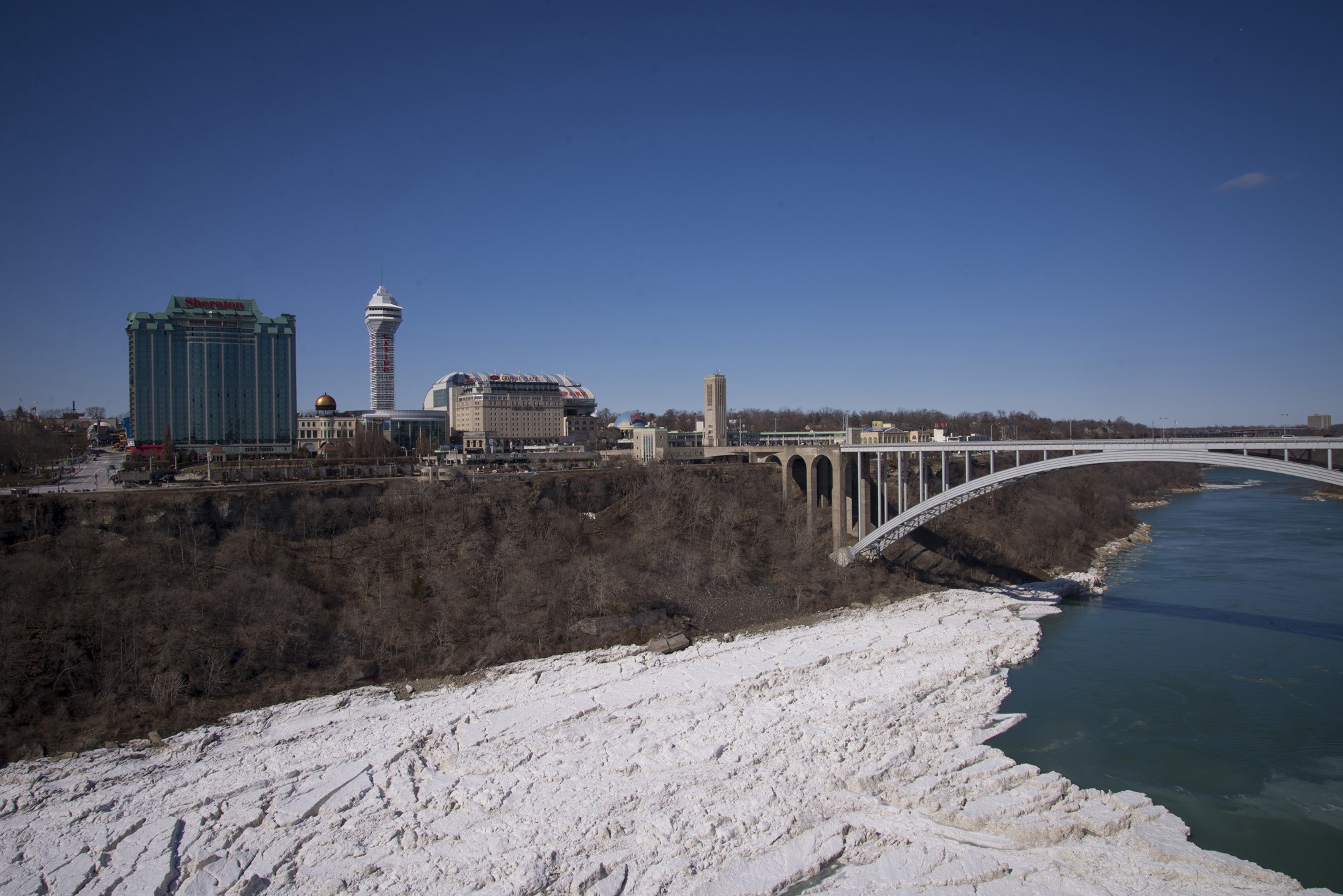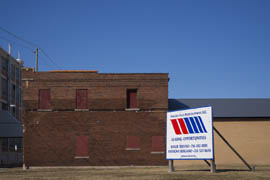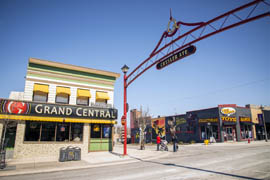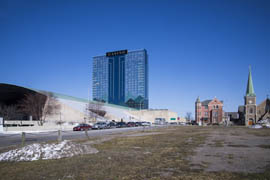Cronkite News has moved to a new home at cronkitenews.azpbs.org. Use this site to search archives from 2011 to May 2015. You can search the new site for current stories.
Cities of Niagara Falls on both sides of border have had highs, lows
NIAGARA FALLS, N.Y. – Mayor Paul Dyster still remembers the headline.
The 59-year-old Niagara Falls native was a sophomore in high school when a classmate in his gym class read from a front-page article in the cross-border Niagara Falls, Ontario, newspaper: “Niagara Falls, Ontario sets forth to make tourism number one industry.”
“They made some strategic decision,” said Dyster. “We thought that was funny.”
Niagara Falls, Ontario, has the last laugh for now.
Separated by Niagara River and sharing the natural wonder of the falls, the two cities have had their fair share of highs and lows.
On the Canadian side, Niagara Falls has grown economically due to its investment in tourism in the 1970s, the strategic move that Dyster recalls so vividly. It’s become a tourist center with two casinos, a giant Ferris wheel, open parkways and, of course, the falls. But it, too, has its challenges.
Its population, now 83,000 is growing but at a much slower rate than the national average in Canada. Its unemployment rate is 9.2 percent, two percentage points higher than the country as whole. So it’s now seeking ways beyond tourism to continue the city’s growth despite some challenges with the provincial government.
“We’re not afraid of the failure,” Niagara Falls, Ontario Mayor Jim Diodati said. “Failure is not the opposite of success. Failure is the path to success. If you don’t fail, you don’t succeed.”
On the other side, Niagara Falls, N.Y., peaked with a population of over 102,394 in 1960, a number that has shrunk to a little over 50,000 residents today. The city regularly has had New York’s highest unemployment rate; in December 2012 it hovered close to 12 percent. It has been on the decline due to the withering industrial sector over the last 40 years. And its history includes one the nation’s worst environmental disasters, Love Canal.
The city feels it has gained some traction over the last decade, but it’s struggling to remain just that – a city. If Niagara Falls, N.Y. falls below 50,000 in the next Census, it will lose its classification as a city. The city wouldn’t qualify for certain federal financial support as a result.
“We face the challenge now of trying to undo stuff that was done 40 or so years ago to get back to more normal situation,” Dyster said. “If we make the right decisions, then hopefully prosperity follows.”
History
Long before all the casinos, hotels and Ferris wheel, Niagara Falls was looked as a source for power generation. It started in the early 19th century when settlers arrived from Connecticut to the New York side and built mills powered by the water.
The industrial sector grew in the late 19th century with the introduction of hydroelectricity. Local historian Paul Gromosiak said people flocked from the South to find work in the factories powered by the falls during the 1920s.
“They could care less about parkland, they could care less about beauty – they wanted money,” Gromosiak said.
Meanwhile, Niagara Falls, Ontario, got a late start on the industrial boom. After the American Revolution, Canada was under British rule and it felt another war with the United States was possible. Gromosiak said it enacted a rule in 1791 for military defensive purposes declaring that nothing could be built 20 meters, or 66 feet, from the bank of the Niagara River. It had to be kept open in case of another war, which soon happened with the War of 1812.
“That’s why you see all the parkland there,” Gromosiak said. “There were no industries there. No buildings to speak of.”
Gromosiak said manufacturing peaked in the 1950s right after World War II for Niagara Falls, N.Y., leading to the city’s population peak in 1960.
Similar to the rest of the country, businesses in Niagara Falls, N.Y., fought with unions over wages. With the city’s lure of hydroelectricity negated by nationwide accessibility to electricity, many companies moved to the South for cheaper labor.
“The people who were working here still went on strike, still gave industries a hard time and they paid for it,” Gromosiak said.
The change
At the same time, Niagara Falls, Onatario’s population jumped from 22,351 in 1961 to 67, 163 in 1971. It didn’t have quite the number of factories as Niagara Falls, N.Y., but the city gained some traction with the bold move to invest in tourism, a decision which many in Niagara Falls, N.Y., expected to fail.
“We knew what an industry was,” Dyster said. “The chemical industry — that was an industry. The steel industry — that was an industry.”
It turned out that the Canadian twin city was correct that tourism is an industry as well. In fact, today it ranks as one of the most reliable and sustainable; the World Travel & Tourism Council projects Travel & Tourism direct contribution to global GDP at 3.1 percent in 2013, which will out-perform the wider global economy at 2.4 percent.
Over the last 30 years, Niagara Falls, Ontario, has developed Clifton Hill into the most popular tourist destination around the falls by building hotels, restaurants and two casinos, Casino Niagara and Niagara Fallsview Casino Resort.
Casino Niagara started as a test-pilot casino in 1996 and its success spurred the efforts for construction of a more elegant Niagara Fallsview Casino Resort in 2004. Mayor Diodati said Ontario Lottery Gaming is the biggest employer in the region with 4,500 jobs.
“It fits in nice because I like to say Niagara Falls offers a buffet of entertainment,” Diodati said. “There’s something here for everybody.”
Niagara Falls, N.Y., continued to struggle as companies and people kept leaving the city. City Planner Tom DeSantis said it was obvious in the early 1980s manufacturing would never return to have the same impact as it did 20 years ago.
The push to find the next paradigm for the city had pedestrian ambitions. While some city leaders recognized the trend of factories leaving city, the general populous was more resistant to moving away from manufacturing.
“In some ways, we’ve been on a downward spiral because of that massive industrial employment that we enjoyed,” DeSantis said.
DeSantis recalled a number of years where Niagara Falls, N.Y. didn’t have capital budgets, used for long term planning projects or repairs. It couldn’t fix roads and infrastructure around the city that desperately needed rehabilitation.
“We were a poor place getting poorer and we couldn’t allocate a lot to capital funds,” DeSantis said. “…That doesn’t go for very long before you can’t get out of that cycle.”
Things slowly changed when Seneca Nation of Indians built Seneca Niagara Casino in 2002. The Seneca Nation of Indians signed a Gaming Compact with the State of New York, which allowed the Seneca Nation to offer “class III gaming” casino facilities. This includes slot machines, table games and “other amenities and offerings typical of Las Vegas style casinos,” according to the Seneca Nation’s website.
The city received a portion of the casino’s revenue in exchange for the exclusive right to offer “class III gaming” west of State Route 14. The revenue allowed Niagara Falls, N.Y. to catch up on deferred maintenance on streets and buildings.
“Those are not things that grab headlines,” DeSantis said. “‘City cleans streets.’ That doesn’t do it, but really that’s what starts to change perception. Things got clean.”
The cleanup efforts, DeSantis said, showed the investment world there’s a plan in place in Niagara Falls, N.Y. Through the Seneca Niagara revenue and USA Niagara, a state subsidiary assisting in developing commercial projects, the city has seen a wave of hotels either renovated or constructed in the last few years with more waiting for approval.
“The casino revenue is the biggest single thing we’ve got coming through that door,” DeSantis said.
Issues
The casinos have been more a headache for both sides of the border in recent years. however.
The Seneca Nation of Indians stopped making payments in spring 2010 because it felt the state of New York broke the agreement with the addition of video slot machines in the state’s nine racetracks. The two sides are currently in arbitration, but Mayor Dyster estimates the Seneca Nation owes Niagara Falls, N.Y., about $60 million over the past 3 ½ years, its share of revenue as a third-party beneficiary.
“The irony in all of this is the city kept its obligation to everyone in all of this,” Dyster said. “The city has really good relations with the officials in Albany and Governor Cuomo and the city has really good relations with the Seneca Nation.”
The dispute has threatened to halt the progress made in Niagara Falls, N.Y. Dyster said the revenue made a big difference in the city’s ability to participate in economic development projects.
There’s no timetable on when the two sides will come up with a resolution.
The Seneca Nation of Indians declined to comment. The governor’s office did not return multiple attempts for a comment.
The dispute could lead to a non-Indian casino in the city. New York Gov. Andrew Cuomo has proposed three non-Indian upstate casinos, but the state constitution does not allow casino gambling beyond tribal facilities. The state is pushing a general election vote to change the constitution on this issue in November, but it could get pushed back to 2014 in order to receive greater turnout.
The state has not decided the location of the three upstate casinos, but DeSantis believes Niagara Falls, N.Y. could benefit with the addition of the casino.
“State-run casinos here would be very beneficial both to the state, to whoever puts them up – the operators – and of course the city of Niagara Falls,” DeSantis said.
“We’re assuming that if they’re state-run, they’d be taxable entities and there would be revenues from that.”
Dyster hesitated when asked whether the city can support another casino. While he’s in favor of any project that benefits the city, he doesn’t think business will double with a second casino.
“Largely this is an issue that’s going to be decided by the market,” Dyster said. “Casino finance is a very specialized field and if the people that track the industry don’t feel there’s room for a second casino, then whatever the law says, they’re not going to loan them the money and make it happen.”
His concerns may be due to the casino battles in Niagara Falls, Ontario, where Diodati thinks Ontario Lottery Gaming wants to shut down one of the city’s two casinos.
Diodati said OLG was supposed to upgrade and rebrand Casino Niagara, the city’s oldest casino, and it hasn’t happened. The casino originally called for a 5,000-7,000 seat theater but Diodati said it was scrapped and instead the casino increased the gaming floors. Diodati said the casino no longer has valet service and tour buses no longer stop at the casino. Instead, they skip to Niagara Fallsview Casino Resort.
“It’s basically a skeleton of a casino,” Niagara Falls Small Business Consultant Angela Davidson said.
Even OLG billboards around Buffalo, N.Y. and inside the Walden Galleria mall mention no word about Casino Niagara but focus specifically on Niagara Fallsview Casino Resort.
“That’s what they’re trying to do – set it up to fail,” Diodati said. “Even the casino sign that faces the USA, facing the Rainbow Bridge was burned out for the longest time until I made a stink about it and they replaced the burned out letters. That is a sign that says we’re closed for business. That is a sign that says don’t come here.”
An Ontario economic report suggested in 2012 that the province should shut down Casino Niagara to help with Ontario’s deficit. Revenue from the two casinos dropped by $18 million in 2011. OLG said in the report the 2.9 percent decrease was due to the introduction of U.S. passport laws and a strong Canadian dollar.
OLG did not respond for comment despite multiple attempts.
The city took another hit from the casinos after OLG won a property tax assessment appeal in March. The casinos received a $16.4 million refund for after successfully arguing that a 2004 property tax assessment was too high. The ruling says the city will have to refund $5.4 million and the Niagara region and school board must pay the rest.
Diodati said the city has appealed the assessment review, which could take a few years to complete.
Along with the $5.4 million it must repay, going forward the city will lose $3 million a year with the changed property-tax assessment. Diodati said $3 million represents a 6-7 percent increase to the average taxpayer in Niagara Falls, Ontario, and the city recently had a three percent tax-hike.
The biggest concern for the city is if the rest of the property on Clifton Hill will be reevaluated in the same way as the casinos. It could result in millions dumped on the taxpayers and other sectors in the city.
“It’s the wrong direction,” Diodati said. “The original mandate of OLG was to stimulate the economy and it’s done just that. … This new approach is going to weaken the economy rather than strengthen the economy. They become money hungry and addicted to the revenues that they’re trying to take them out.”
Future
In the midst of these challenges, both cities look for new ways to stabilize their economies beyond the Falls.
Niagara Falls, N.Y., plans to relocate its Amtrak station to downtown near the Whirlpool Bridge with the help of a federal Transportation Investment Generating Economic Recovery grant and state funding. The project has been 30 years in the making and it’s expected to be completed in 2014. The Amtrak line connects two of the largest cities in North America – New York City and Toronto. It would bring more foot traffic into downtown and could bring an economic boost to the city.
The site is also an Underground Railroad marked site. The station will include a museum detailing the historical significance of the location.
“You have this historical site here and you have the 7th wonder of the world in the Falls on the other end of Main Street,” City Council member Charles Walker said. “As you begin to connect that, you can fill Main Street in with other opportunities I believe.”
Niagara Falls, Ontario, has pushed for a youthful movement, starting with its new city slogan “be nf.” The double entendre means to “be Niagara Falls”, but Diodati also wants it challenge the city to “be enough”.
With the drop in U.S. tourists due to the changed passport rules, Diodati has attempted to attract people from emerging countries like China, India and Brazil to the area. Tourism has increased this year as a result of the change in strategy.
“They’ve got a developing upper and middle class where there’s money,” Diodati said. “They want plasma screens, and they’re on the Internet and they see the world. They want to come see the world themselves. They don’t want to read about Niagara Falls. They want to come see it as part of their bucket lists.”
The city also wants to grow outside of tourism and push toward small and medium businesses. It has created a new industrial zone from Niagara Falls to Fort Erie with lower development charges. The aim is still to grab manufacturing jobs but the focus now is on green innovative companies and biodiesel manufacturers.
“We will always have a large tourism industry that we will continue to try and grow,” Davidson said. “I just think it’s important moving forward in the sustainability of our economy that we also work just as hard to attract the small and medium businesses.”
The comparisons between the two cities will be drawn out until eternity. Growing up in Niagara Falls, Ontario, Diodati would say it’s one city split by a river.
“On some level, we’re competitive but like siblings are with a family, but at the same time we’re in this together and we want to see each other succeed,” Diodati said. “It’s going to better the both of us if each of us successful.”
Niagara Falls, N.Y. had the first laugh. Niagara Falls, Ontario has the last laugh for now, but this sibling rivalry is far from over.











